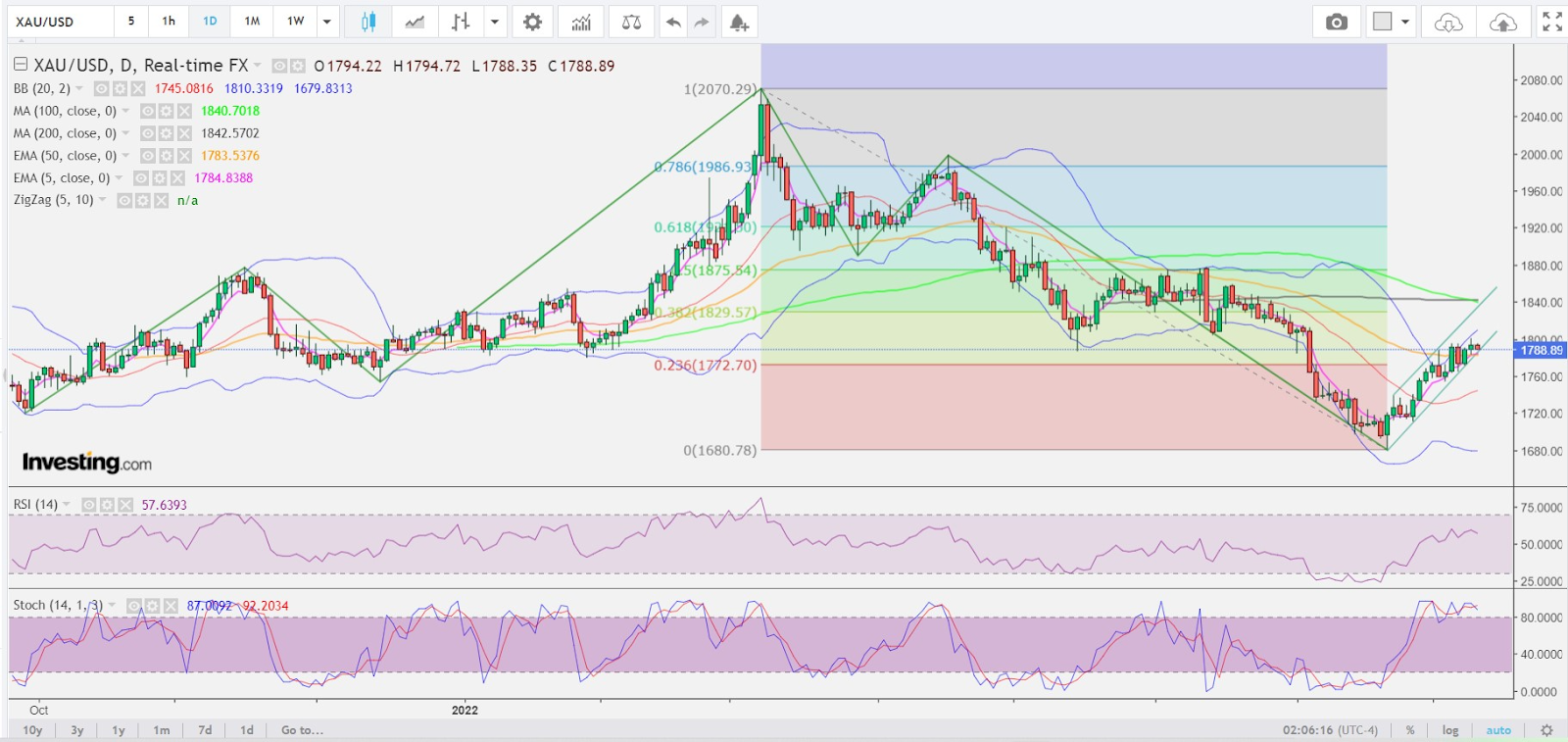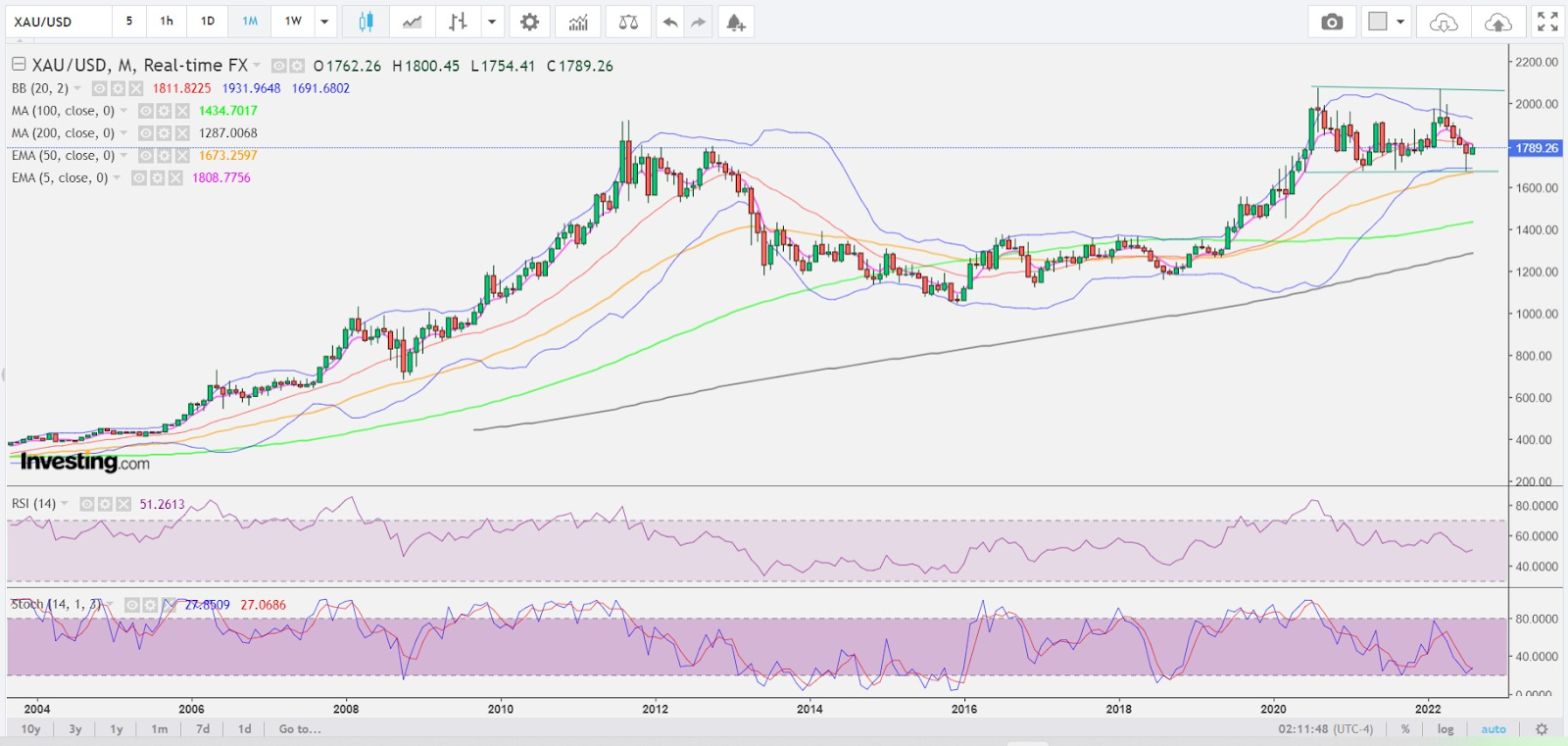- Seven weeks until next US rate hike
- Stronger-than-forecast July CPI could hurt gold
- But the damage likely won’t last given bullion’s recent momentum
Is gold’s inflation-play back?
Before we try and answer that, how about a more elementary question: Could the yellow metal survive the U.S. Consumer Price Index report for July, especially if it delivers another searing number on inflation that will serve as an indictment of the Federal Reserve’s months-long effort in containing price growth?
The answer seems to be 'yes' beyond the immediate term, and we’ll explain why.
The bottom line is that a CPI report that isn’t too damaging to gold will likely help longs in the game continue advancing in the $1,800 region.

Charts by SKCharting.com with data powered by Investing.com
Bullion aficionados will argue that hedging against inflation is an inherent part of the daily flows into the futures, exchange-traded funds, and other vehicles used by investors to access the metal. Gold, they’ll add, has never really diverged from its relationship with inflation; their argument is that only those who don’t understand it will utter the contrary.
Unfortunately, though, gold’s behavior over the past two years hasn’t really lived up to its billing as the ultimate safe haven.
Since hitting record highs of about $2,100 in August 2020, gold has often disappointed its backers more than it has delighted them. Case in point: its descent into $1,600 territory on July 14—the first time since August 2021—after the June CPI report showed annual inflation at a new four-decade high of 9.1%.
That CPI report itself was followed by an epic US jobs report for July on August 5 that showed a creation of 528,000 jobs, more than twice the 250,000 forecast by economists.
The reason gold gets socked after each blockbuster CPI or jobs report is because of the interest rate expectations that they bring and the rally those expectations cause in the dollar and Treasury yields—the two contra trades to gold.
The Fed, as every gold trader knows, wants to bring inflation back to its long-cherished target of 2% a year; or 4.5 times less than what it was for June.
After four increases since March that have brought rates from nearly zero to as high as 2.5%, the Fed is nonplussed that inflation refuses to budge from four-decade highs.
After the August 5 release of the US jobs report, Investing.com’s Fed Rate Monitor Tool initially showed a 67% chance of the central bank implementing a 75 basis point rate hike for September 21—the date for its next rate adjustment.
By August 9, there was only a probability of 52% for a 75-basis point hike, with traders assigning a higher 48% chance for a 50-basis point increase.
Also, unlike previous months, the Fed will have this time two back-to-back US monthly employment reports to peruse before its next rate decision. The next nonfarm payroll report, for August, will be on September 2—some 19 days before the rate decision. There will also be another CPI report, for August, due on September 13. On top of that, the Fed will have its Jackson Hole symposium in Wyoming from August 25-27 to debate at length on what to do with inflation and the economy.
What all these simply mean is that the central bank will have ample time to decide on its next rate hike. The imminent July CPI report will only be one of the many data points telegraphed by the Fed over the next six to seven weeks as it determines what to do with an economy that has slipped into the technical definition of a recession from two straight quarters of negative gross domestic product growth.
This is why we answered 'yes' earlier to the question on whether gold will likely survive a stinging July CPI number.
Aside from the CPI report, the producer price index figures for July will be released on Thursday, along with the weekly report on initial jobless claims, while the University of Michigan consumer sentiment index will be published on Friday. These smaller data points could also help navigate the Fed in its decision-making on rates.
While the mere threat of rate hikes once sent gold bulls scurrying for cover, recent weeks have shown the yellow metal holding its own against such concerns.
In fact, the game may have arguably changed for gold longs. Strong inflation reports, over time, will likely be better for them as these will truly give the metal a chance to prove its worth as a hedge.
This could explain why gold prices have risen in the last two days prior to the CPI report. On Tuesday, the benchmark gold futures contract on New York’s COMEX, December, settled at $1,812.30, up $7.10, or 0.4%. On Monday, it rose $14, or 0.8%. While it was weaker in Wednesday’s Asian trade, December gold held above the key $1,800 level.
Analysts said while the Fed would be inclined to keep raising rates until it gets to that inflation target, longs in gold are also betting on more safe-haven flows concurrently into the yellow metal for those wanting to hedge against economic uncertainties.
Said Ed Moya, analyst at online trading platform OANDA:
“Gold is getting a boost … from both safe-haven flows as stocks weaken and as the dollar softens. Geopolitical risks remain elevated and that could keep gold supported above $1,800 going into year end.”

The short-term impact from an outsized CPI report will likely be damaging to gold, but the yellow metal could also rebound fairly quickly, said Sunil Kumar Dixit, chief technical strategist at SKCharting.com.

Adds Dixit, who uses the spot price of bullion for his analysis:
“If the CPI inflation numbers come in above consensus, gold will likely drop to $1,775 and $1,765. Breaking below $1,754 will change current momentum to bearish and open the gates for a retest of the $1,730-$1,710 region.”
“But if Gold doesn't break below $1,785 and gathers enough momentum to make a sustained break above $1,802 we can expect a break above the previous monthly high of $1,815. The next targets will be $1,828 and $1,842.”
Dixit said major resistance for the current uptrend was at $1,878.
“The short-term momentum is controlled by the 23.6% Fibonacci level of $1,772 and the 38.2% Fibonacci level of $1,830. Buyers and sellers are sitting on fence line at $1,798 to $1,802.”
Disclaimer: Barani Krishnan uses a range of views outside his own to bring diversity to his analysis of any market. For neutrality, he sometimes presents contrarian views and market variables. He does not hold positions in the commodities and securities he writes about.
